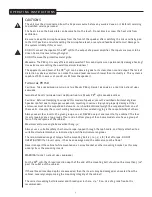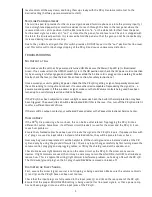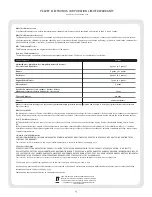
level controls all the way down, and bring them up slowly with the PR 15D volume control set to the
desired setting (halfway up recommended to start).
Mic/Line Pad Adjustment
The mic/line pad (6) provides for the increased gain needed for microphone use into the primary input (5).
Use a straightened paperclip or small screwdriver to reach through the hole in the rear panel where the
recessed tab is to set its position. Set the Mic/Line Pad to “in,” or the white tab furthest from the panel,
for line-level signal use and set it “out,” or closest to the panel, for mic-level use. The unit is shipped with
the tab in the line-level position. It is recessed behind the panel so that the gain can not be inadvertently
increased during transport or set-up.
Due to the 30 dB of extra gain that this switch provides, DO NOT leave it in the “out” position for line-level
use! This will result in input-stage clipping of the PR 15D and cause unnecessary distortion.
TROuBLESHOOTING
No Output at All
First, make sure the unit has AC power and is turned ON. Make sure the Power/Clip LED (4) is illuminated
Green. If not, make certain the ON/OFF switch (3) is in the ON position and check the IEC power cord connection
(2) by ensuring it is fully engaged and seated. Make certain the AC line cord is plugged into a working AC outlet.
Finally, check the fuse (1). (See the Rear Panel: Fuse section, for safety instructions.)
Once assured your unit is getting AC power, check that the PR 15D is getting a signal. Temporarily disconnect
the cable running to its inputs and connect it to some other device capable of reproducing the signal (i.e., a
power amp and speaker). If this produces a signal, make sure that all Volume controls being used have been
turned up to a satisfactory level (one-third to halfway).
If the PR 15D has been subjected to direct sunlight or excessive heat, the built-in thermal protection may have
been triggered. The power/clip LED will be illuminated RED if this is the case. If so, turn off the PR 15D and let it
cool for a sufficient amount of time.
If there is still no output, contact your authorized Peavey dealer or the Peavey International Service Center.
Hum or Buzz
If the PR
®
15D is producing a hum or buzz, this can be AC outlet related. Try plugging the PR 15D into a
different AC outlet. Sometimes, if a different circuit (breaker) is used for the mixer and the PR 15D, it can
cause hum problems.
Ensure that shielded cables have been used to route the signal to the PR 15Ds inputs. If speaker cables with
1/4" plugs are used as input cables instead of shielded cables, they will be prone to hum or buzz.
Hum may be ground loop related. It will be helpful to lift the shield ground on a balanced cable at the PR
15D end only by using the ground lift switch (4). Check any input changes carefully by first turning down the
volume control, plugging and unplugging cables, or lifting the shield ground at the speaker end.
Check to make sure light dimmers are not on the same circuit as the PR 15D, the mixer or any source
devices. If light dimmers are used, then it may be necessary to turn them full ON or full OFF to eliminate or
reduce hum. This is a typical AC wiring/light dimmer interference problem, not a design flaw of the PR 15D.
The third wire (ground plug) on the AC plug should NEVER be removed or broken off.
Distorted or Fuzzy Sound
First, ensure the mixer (signal source) is not clipping or being overdriven. Make sure the volume control/s
(7) and (9) on the PR 15D have not been set too low.
Check that the input plugs are fully seated in the input jacks (5) and (8) on the rear panel of the PR 15D.
Ensure that the proper MIC/LINE PAD setting is being used (6) for line-level signals, or that a power amp
has not been plugged into one of the input jacks of the PR 15D.


































